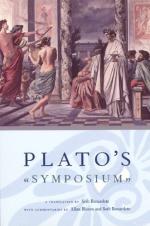
|
| Name: _________________________ | Period: ___________________ |
This test consists of 15 multiple choice questions and 5 short answer questions.
Multiple Choice Questions
1. According to Phaedrus, who are Love's parents?
(a) The earth and the sun.
(b) The moon and the sun.
(c) The gods.
(d) There is no record of Love's parents.
2. Who firsts requests drinking in moderation at the party?
(a) Aristodemus.
(b) Pausanias.
(c) Aristophanes.
(d) Eryximachus.
3. What three elements share a harmonious love in nature, as stated by Eryximachus?
(a) People, water, and plants.
(b) Animals, water, and plants.
(c) People, animals, and water.
(d) People, animals, and plants,
4. What does Eryximachus interpret Heraclitus' words to mean?
(a) Music is the further division of opposites.
(b) Music features similar and opposite factors.
(c) Music has a reconciliation of opposites.
(d) Music features only similar factors.
5. What does Pausanius think is the true test of a love's class?
(a) Past.
(b) Wealth.
(c) Time.
(d) Location.
6. What does Eryximachus say about his omission of certain things in his speech?
(a) It is intentional.
(b) It is not intentional.
(c) He cannot remember any more.
(d) He maintains that he did not leave anything out.
7. With what animal does Aristophanes compare the "man-woman creatures"?
(a) Fish.
(b) Birds.
(c) Rabbits.
(d) Turtles.
8. According to Socrates, who changes proverbs about Agamemnon and Menelaus?
(a) Livy.
(b) Plutarch.
(c) Homer.
(d) Plato.
9. According to Eryximachus, what elements create rhythm?
(a) Short and medium length.
(b) Short, medium length, and long.
(c) Medium length and long.
(d) Short and long.
10. As related by Apollodorus, how many years has Agathon not resided at Athens?
(a) Only a few years.
(b) Agathon still resides in Athens.
(c) Only one year.
(d) Many years.
11. Where does Phaedrus think that Achilles was sent after his death?
(a) Tenedos.
(b) Ionian Islands.
(c) Babylon.
(d) The Islands of the Blest.
12. As explained by Phaedrus, how does Orpheus die as a result of his cowardice?
(a) He is thrown off of a cliff.
(b) He is dragged through the streets.
(c) He is beaten with clubs.
(d) At the hands of women.
13. What was Eryximachus' ancestor, Asclepius, an expert in?
(a) Gymnastic, but not husbandry.
(b) Neither gymnastic nor husbandry.
(c) Gymnastic and husbandry.
(d) Husbandry, but not gymnastic.
14. As Eryximachus explains, what is harmony composed of?
(a) High and low notes.
(b) Neither high nor low notes.
(c) Only low notes.
(d) Only high notes.
15. Where is Socrates before entering Agathon's house?
(a) The dining room of a house that is two houses away.
(b) The portico of the neighboring house.
(c) The dining room of the neighboring house.
(d) The portico of a house that is two houses away.
Short Answer Questions
1. According to Aristophanes, why do the "double-man" or "double-woman" creatures marry?
2. What does Aristophanes state that mankind does not understand?
3. Who requests that Socrates sit near him at the party?
4. What news does Agathon give to Aristodemus when he arrives?
5. In Aristophanes' opinion, why do the gods make changes to humans?
|
This section contains 510 words (approx. 2 pages at 300 words per page) |

|




